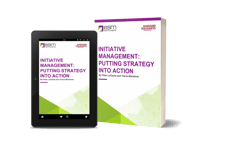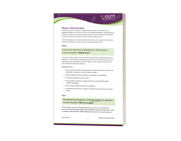Glossary of Balanced Scorecard Terms
Get to know the common terms and phrases related to Balanced Scorecards.
Glossary of Balanced Scorecard Terms
Accountable
Individual or team responsible for completing a particular piece of the strategy e.g. initiative, task, action item. The accountable person(s) should be senior enough to ensure the successful completion of the strategic work, both from a competency and a political/influence standpoint.
Adapt (Make Strategy a Continual Process)
A key principle from Robert S. Kaplan and David P. Norton’s Strategy-Focused Organization methodology. Organizations adapt their management systems so that both strategy and tactics are managed as a "double-loop" process on a continual basis. They accomplish this by linking strategy to the budgeting process (yielding both operational and strategic budgets), to the management meeting (yielding both operational and strategic performance reviews), and to the learning process (yielding both operational and strategic information systems).
Align (Align the Organization to the Strategy)
A key principle from Robert S. Kaplan and David P. Norton’s Strategy-Focused Organization methodology. An organization achieves strategic alignment when the whole of the organization exceeds the sum of its parts. This synergy occurs when all parts of the organization focus on strategic themes and priorities as defined by their strategy map and corresponding Balanced Scorecards for the corporate, business unit and support units.
Balanced Scorecard (BSC)
At the highest conceptual level, the Balanced Scorecard (BSC) is a framework that helps organizations translate strategy into operational objectives/strategies that drive both behavior and performance.
Cause and Effect Relationship
In the context of the BSC, a cause and effect relationship identifies the initiatives, responsibilities or activities (causes) necessary to achieve an objective or target (effect). A cause and effect relationship can also exist between strategic objectives and perspectives on a strategy map.
Core Team
Group responsible for launching the Balanced Scorecard initiative. This group attends all team meetings and consists of 2-6 cross-functional members.
Customer Intimacy
A deep understanding of an organization’s market groups. The ability to combine detailed customer knowledge with operational flexibility in order to respond quickly to almost any need -- from customizing a product to fulfilling special requests -- is the result of customer intimacy.
Customer Value Proposition
Defines who the customer is and what they want.
ESM Software, LLC.

A professional services firm that facilitates the worldwide awareness, use, enhancement, and integrity of the Balanced Scorecard as a value-added management process.
Financial Model
A model comprised of the economic drivers of overall shareholder value.
Hypothesis
A proposition about cause and effect relationships. A hypothesis involves anticipating an effect, and a means of observing whether the anticipation is correct. A company’s strategy is based on a hypothesis – “If we do A, then B will result.” A strategy map for a Balanced Scorecard explains the hypothesis behind an organization’s strategy.
Initiative
 Key action programs developed to achieve objectives or close gap between measures performance and targets. Initiatives are often known as projects, actions, or activities. They differ from objectives in that they are more specific, have stated boundaries (beginning and end), have a person/team assigned to accomplish them, and have a budget. Several initiatives taken together may support a specific objective or theme. It is important for an organization to define the boundaries for Initiatives, such as “all strategic projects over $500k in size”. It is also important that Initiatives be strategic in nature, and not “operations as usual” projects, such as “Recruit a new Sales Rep." Examples:
Key action programs developed to achieve objectives or close gap between measures performance and targets. Initiatives are often known as projects, actions, or activities. They differ from objectives in that they are more specific, have stated boundaries (beginning and end), have a person/team assigned to accomplish them, and have a budget. Several initiatives taken together may support a specific objective or theme. It is important for an organization to define the boundaries for Initiatives, such as “all strategic projects over $500k in size”. It is also important that Initiatives be strategic in nature, and not “operations as usual” projects, such as “Recruit a new Sales Rep." Examples:
- “Develop Quality Management Program”
- “Install ERP System”
- “Revamp Supply Chain Process”
- “Develop Competencies Model."
Innovation
The introduction of something new – a new idea, method, or device. Any artifice that generates a new pattern of use, behavior, or thinking that is different from previous patterns in the same field.
Lag Indicator
Measures to determine the outcome of an objective that indicate company performance at the end of a period. These are results-oriented and do not reflect a process. Examples include:
- Year-end Sales
- Cycle Time
- Market Share.
Lead Indicator
Measures that indicate progress against a process or behavior. These measures are helpful in predicting the future outcome of an objective. Examples include:
- Hours Spent with Customers
- # of Meetings with Cross-Functional Representation
- # of Process Reworks
Leadership Team
The executive team that reviews and confirms the strategic architecture developed by the Core Team.
Measure/Key Performance Indicator (KPI)
Statement of how success in achieving an objective will be measured and tracked. Measures are written statements of WHAT we will track and trend over time, NOT the actual targets such as direction and speed. A measure should include a statement of the unit to be measured ($, headcount, %, rating). Examples:
- “Year over Year Sales ($)” (Financial)
- “Customer Satisfaction Rating” (Customer)
- “Service Error Rate (%)” (Internal)
- “Strategic Skills Coverage Ratio” (Learning & Growth).
Measures Team
Group responsible for identifying scorecard measures and recommending targets.
Milestone
The set of specific deadlines or hurdles that signal progress in completing an Initiative. Milestones include progress/completion dates or % completion rates, key presentations/meetings, and key decision points. Examples:
- (For the Initiative “Develop Competencies Model”)
- “Competencies defined by 10/1/29”
- “Model Completed by 1/15/29”
- “Model Approved by 2/1/29."
Mission
 Concise, internally focused statement of the results (usually financial, process, or customer service oriented) sought by the organization over the mid-long term (3-5 years). The mission is often a statement of the “Financial Gap” or financial goal over this time period. Examples:
Concise, internally focused statement of the results (usually financial, process, or customer service oriented) sought by the organization over the mid-long term (3-5 years). The mission is often a statement of the “Financial Gap” or financial goal over this time period. Examples:
- “Increase Market Share to 25% by 2029 by outsmarting the competition”
- “Win market share by being the most cost effective supply chain manager of retail fashion products."
Mobilize (Mobilize Change through Executive Leadership)
A key principle from Robert S. Kaplan and David P. Norton’s Strategy-Focused Organization methodology. A Strategy-Focused Organization mobilizes change when executives launch and manage a strategy-driven change process with visible energy and committed ownership. The typical executive champions a strategic change by establishing a sense of urgency, creating a guiding coalition, and developing a vision and strategy to guide behavior. After the change process is launched, a revised governance system navigates the transition, followed by more permanent structural changes in the management system which affect resource allocation and compensation.
Motivate (Make Strategy Everyone's Job)
A key principle from Robert S. Kaplan and David P. Norton’s Strategy-Focused Organization methodology. Strategy-Focused Organizations motivate their people to execute strategy when they use the Balanced Scorecard as a communications tool for educating every single associate. As individuals set personal work objectives which align with the organization's Balanced Scorecard, and are thereafter rewarded with compensation and recognition for both individual and team accomplishment; the strategy becomes part of their everyday jobs.
Objective
Concise statement articulating a specific component of what the strategy must achieve/what is critical to its success. Each perspective usually contains 3-6 primary objectives that state a key aspect of the strategy to be achieved over the next 3-5 years. Objectives are best stated as action phrases (verb/object) and may include the means and/or desired results as well as the action. Examples:
- “Increase Market Share Through Current Customers” (Financial)
- “Be Service Oriented” (Customer)
- “Achieve Order Fulfillment Excellence Through On-line Process Improvement” (Internal)
- “Align Incentives and Rewards With Employee Roles for Increased Employee Satisfaction” (Learning & Growth).
Organizational Enablers
Skills and knowledge, the tools and resources, and the culture of the organization that will enable it to achieve strategy.
Outcome Measure
Measures to determine the outcome of an objective that indicate company performance at the end of a period. These are results-oriented and do not reflect a process. Examples include: Year-end Sales, Cycle Time, and Market Share. Outcome measures often appear in the BSC’s outcome-oriented Financial and Customer perspectives.
Performance Driver
Measures that indicate progress against a process or behavior. These measures are helpful in predicting the future outcome of an objective. Examples include:
- Hours Spent with Customers
- # of Meetings with Cross-Functional Representation
- # of Process Reworks
Performance Indicators
Measures of WHAT a company will track and trend over time, NOT the actual targets such as direction and speed. A performance indicator should include a statement of the unit to be measured ($, headcount, %, rating). Examples:
- “Year over Year Sales ($)” (Financial)
- “Customer Satisfaction Rating” (Customer)
- “Service Error Rate (%)” (Internal)
- “Strategic Skills Coverage Ratio” (Learning & Growth).
Perspectives
The set of (usually) four “viewpoints” to a strategy as represented by key constituents/stakeholders of that strategy. Viewed horizontally, each perspective represents the set of objectives desired by a particular stakeholder (Financial, Customer, Internal Process, Learning & Growth/Employees). The perspectives, when taken together, permit a complete view of the strategy and “tell the story of a strategy” in a clearly understandable framework. In unique circumstances, organizations may include a customized perspective in addition to the four listed above. Example: “Financial”, “Customer”, “Internal Processes”, “Learning and Growth” Other possible perspectives include “Regulatory” and “Environmental”).
Resource Allocation/Funds Budgeted $
The specific dollar budget or resource amount allocated to a particular initiative. This amount should be presented in total, and can also be decomposed over specific periods, such as years/quarters, as appropriate to the budgeting/strategic planning process. Example: (For the “Competency Model Development” Initiative), $300K total, $100K in 2029 for development, $200k in 2029 for rollout.
Strategic Architecture
Linkages across scorecards that establish the theory of managing shared service units and decentralized business units within a single corporate entity. A strategic architecture describes organizational synergies by integrating the activities of otherwise segregated and independent units.
Strategic Destination
The overarching goal of the company.
Strategic Plan
When taken together, all of the Balanced Scorecard components represent a strategic plan. This form of strategic plan ensures the linkage between an organization’s strategy and its activities. It also ensures consistency across the organization from a framework and definitional standpoint.
Strategy
Description of what the organization is attempting to accomplish over the next 3-5 years, as represented by the organization’s themes and objectives, taken collectively. By stating the strategy in terms of themes and objectives, the strategy will be represented in a concise, holistic, process-oriented manner, rather than financial-only or departmentally segmented.
Strategy Map
A visual representation of an organization’s strategy and the processes and systems necessary to implement that strategy. A strategy map will show employees how their jobs are linked to the organization’s overall objectives.
Strategy-Focused Organization (SFO)
A Strategy-Focused Organization places strategy at the center of its management processes – strategy is central to its agenda. There are five principles to a Strategy-Focused Organization: Mobilize Change through Executive Leadership; Translate the Strategy to Operational Terms; Align the Organization to the Strategy; Make Strategy Everyone’s Job; Make Strategy a Continual Process.
Target
The level of performance or rate of improvement required for a particular measure. Targets are stated in specific units ($, #, %, Rating, etc.), and should include time-based segments (annually, quarterly, etc.) as appropriate. Targets should be observed over time to determine important trending behavior, so that corrective action can be taken as needed. Example: (For the Measure “Year over Year Sales”), 2029: $30M, 2030: $35M, 2031: $38M.
Theme
Descriptive statement representing a major component of a strategy, as articulated at the highest level in the Vision. Most strategies can be represented in 3-5 themes. Themes are most often drawn from an organization’s internal processes or the customer value proposition, but may also be drawn from key financial goals. The key is that themes represent vertically linked groupings of objectives across several scorecard perspectives (at a minimum, Customer and Internal). Themes are often stated as catchy phrases or “buzz” words that are easy for the organization to remember and internalize. Example: “Top Innovator,” “Customer Intimate,” “Operationally Excellent” “Processes/Tools,” “Thinking,” “Content,” “Pipeline” (I/T Organization).
Translate (Translate the Strategy to Operational Terms)
A key principle from Robert S. Kaplan and David P. Norton’s Strategy-Focused Organization methodology. A Strategy-Focused Organization translates strategy into action when it organizes a "strategy map" framework of cause and effect between its strategic objectives, then operationalizes these objectives with measures which, considered as a group, comprise a Balanced Scorecard. This "hypothesis" about how the strategy will create value involves objectives drawn from, at a minimum, four perspectives: Financial, Customer, Internal Process, and Learning and Growth.
Value Chain
The process steps by which a company moves from the identification of its customer needs to customer fulfillment.
Value Proposition
A value proposition is the unique mix of product, price, service, relationship and image that a provider offers its customers. It determines the market segments to be targeted and how the organization will differentiate itself in those segments, relative to its competition.
Vision
Concise written statement defining the mid-long term (3-5 year) strategy of the organization. The vision is the summary statement of how the organization wants/intends to be perceived by the world. The statement is external/market oriented, brief (1-3 sentences), and stated in “visionary,” colorful terms. Example: Become the respected leader in financial services with a focus on end-to-end customer relationships and satisfaction, resulting in optimized balance sheets for our partners.


